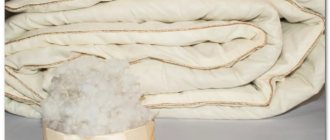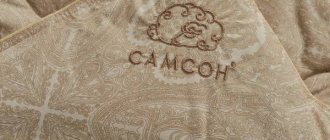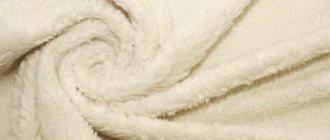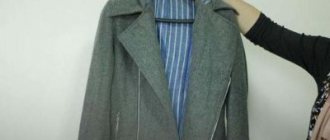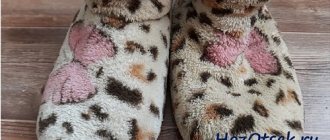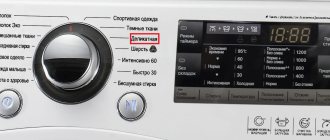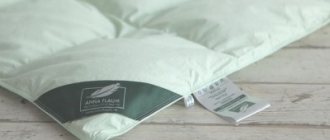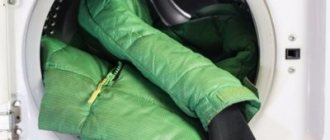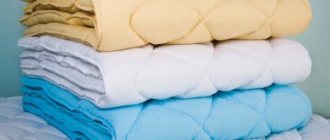Features of cleaning the material
To refresh an item, get rid of an unpleasant odor or random stains, you need wet cleaning. Many housewives are afraid to wash blankets, believing that this will harm the product: the filling will become crumpled, the heat retention properties will deteriorate, etc. Even the instructions from the manufacturer indicate that such manipulations will not be beneficial. But, as practice has shown, the effect is the opposite. Of course, if everything is done correctly.
This is interesting: holofiber is a non-woven fiber of synthetic origin. Hypoallergenic polyester is used for production.
Is it possible to wash a holofiber blanket in a washing machine?
You don't have to do all the cleaning by hand. Modern household appliances are quite capable of handling the washing of a blanket without significant harm to it. But not every model is capable of this.
Machine requirements:
- Large drum so that the product fits easily. Volume designed for at least 6 kg.
- One of the following SMA programs: “Volume clothing”, “Pooh. Blanket", "Delicate wash". Some of them are even in older models.
After making sure that the home assistant is suitable, you should determine whether drastic measures are really necessary.
Characteristic
Holofiber blankets and pillows are very popular nowadays. They last a long time, are suitable for any season of the year, and are inexpensive. Externally, they are similar to cotton or down products.
The sleeping accessories have a soft texture, they are light and pleasant to the touch. Many people like to sleep without feeling the weight of a blanket. The products retain their original shape for a long time.
The material is not filled with germs and parasites. It is safe for people with sensitive skin.
For the manufacture of individual models, bamboo fibers are used in combination with holofiber. The result is a light and silky product. It has good throughput and antiseptic properties.
Is it time to cleanse?
The frequency of wet cleaning depends on several factors:
- Is a duvet cover used and how often is it changed?
- Is the blanket aired at least once a month?
- Operating conditions, which include the presence of food in bed, who sleeps under the covers, etc. For example, men sweat more than women during sleep.
Even if you can hardly remember the last time you cleaned your blanket, you need to assess its condition so as not to waste your energy:
- Remove the duvet cover and check for stains. Fresh stains can be removed without resorting to a full-scale wash.
- Smell the blanket. If there is an unpleasant odor, take the item out into the fresh air for a couple of hours.
If all these manipulations turn out to be ineffective, it is better not to neglect wet cleaning.
Important: after removing dirt using a steam unit, make sure that the treated area is dry before using the item for its intended purpose.
On average, you can wash a product with holofiber no more than once every 4 months. The main thing is to correctly perform all the steps in the right sequence, otherwise the product will lose its shape.
Care Tips
To maintain the attractive appearance of the blanket and the beneficial properties of its filler, adhere to the following recommendations:
- Air the fabric between washes.
- Do not use chlorine-containing products.
- Always use a duvet cover.
- Store items only when they are clean.
Crumpled holofiber can be revived using a comb or brush. To do this, remove the filler from the case and thoroughly fluff each lump. Then put the fibers back in place. The blanket will become light and airy again.
The filler is sold separately and is inexpensive, so you can update the product yourself.
Holofiber is easy to care for: it can be washed both manually and in an automatic machine. Products with synthetic filling for blankets have many positive properties and are suitable even for people suffering from allergies and asthma. The low cost makes such home textiles affordable.
How to wash a holofiber blanket in a washing machine
In order for the result to be what you expect, you will have to try. It’s not enough to stuff something into a centrifuge, turn on the first mode you come across and wait.
This is interesting: the blanket retains heat thanks to holofiber. This filler does its job so well that it is even used in winter jackets.
Preparation
- Check the condition of the product. There should be no holes, protruding threads or other damage. Otherwise, the item will become hopelessly damaged after a cycle in the washing machine.
- Shake the blanket several times to remove dust. It's better to do this outside.
Prohibitions
- Do not use powdered cleaners or conditioners. Only liquid gels are acceptable.
- Do not wash damaged items.
- Do not use a blanket that has not had time to dry for its intended purpose.
- Hot water has a detrimental effect on synthetic fillers. Hollofiber is subjected to heat treatment during manufacturing, and repeated contact with high temperatures will radically change the properties of its fibers. You can only wash in conditions of 30-40 °C.
Step-by-step instruction
- Carefully load the product into the drum. It is better to refuse a special laundry bag.
- Pour liquid cleaning agent into the dispenser cuvette. We recommend giving preference to substances for delicate fabrics.
- Select the appropriate mode on the control panel. Start the washing process and wait until it finishes.
- When the machine is set up manually, you need to select the following parameters: 30-40 °C water temperature, maximum number of revolutions.
Important: the “Drying” mode is contraindicated for all products with holofiber filling. But it’s better not to turn off the spin. After this, the blanket will quickly regain its shape.
Advantages
- Thanks to the special spiral structure of the fibers and the air pores formed between them, the filler holds its shape and does not bunch up.
- The material does not cause allergic reactions. Things with such filling can be used by allergy sufferers and asthmatics.
- Dust mites will not grow in this material: there is no food for them in synthetic fibers.
- High wear resistance and long service life.
- High moisture resistance. Water procedures do not affect the properties and structure of the filler.
Handwash
When the product is too large, the only possible option is to wash it by hand. This will require more effort. The process is safer for the blanket, but it will also take a lot of time.
Step-by-step instruction
- Pour water at the required temperature into the bath and dilute the selected product in it.
- Roll the blanket into an oblong roll and immerse it in the liquid for 15 minutes.
- The washing itself is carried out by unfolding and then folding the product. Repeat several times.
- You can use laundry soap or stain remover locally. Most often this refers to the border.
- Drain the water and, if possible, squeeze out excess water from the item with open palms. Use clean rinse liquid to get rid of soapy water.
- Let the water drain again and squeeze with your hands, but do not twist.
Varieties
May have several types. All varieties are made from polyester fibers and differ only in density and thickness. Depending on the thickness and length of the thread, thermofiber is divided into:
- Soft. The material is soft, light and very closely resembles natural down. It is universal and can be used in various areas where insulation is necessary. The thickness to length ratio is 7D/32.
- Hard. The ratio of fiber diameter to length is 15D/64. The canvas has good elasticity and quickly restores its original shape. Less elastic, therefore suitable for filling large parts.
- Vatu. In appearance, the water resembles natural cotton material. It is characterized by low density and low weight. Thin fibers are short in length, which ensures the airiness of the material. However, it is less durable than other varieties.
- Balloons. They are made from both hard and soft threads. Strongly twisted fibers are collected into small lumps-balls. The variety is characterized by an increased degree of elasticity and restoration of condition.
How to dry it properly?
The last process will not cause you any problems. The blanket can be dried in any position. But there are several nuances:
- If washing was done by hand, you must first let the water drain and then straighten it using a special device or stretcher.
- Choose a day with sunny weather, when there is somewhere to hang it outside.
- During the process, periodically beat the filler with your hands.
Important: holofiber fibers do not absorb water, so even with prolonged drying the product will not “suffocate”.
Determination of product density
When sewing blankets, fillers of different densities are used, which determine the warmth. There are points on the packaging that determine the degree of density of the product.
In addition to these models, there are universal ones. The four-season blanket includes several layers that are fastened with buttons or snaps. Double-layer blankets are in great demand.
How to restore a product if something goes wrong?
Did you wash or dry it incorrectly and end up with your bedding turning into a piece of fabric with lumps inside? Don't worry, the item can still be saved.
Tips for rehabilitating the properties of the filler:
- You will have to sacrifice the integrity of the product and rip it open.
- Place handfuls of holofiber on a simple comb and pull them between the teeth of the brush. This must be done with each lump.
- Place everything evenly back into the case, trying not to squeeze the fluffy holofiber. Sew up the hole.
Tip: you can buy a new filler. Its cost is much cheaper than a ready-made blanket. Use the old one for other purposes.
As a last resort, you can always take the item to the dry cleaner, but this pleasure is not cheap. The price for specialist services varies from 900 to 5000 rubles.
Classification according to the method of filler distribution
The filling in the case can be positioned differently, which affects the quality of the product.
Types of blankets according to the distribution of hollafiber:
- quilted;
- Karostep;
- cassette
In the first type, the filling is quilted with a cover. This is the cheapest option. The product has a minimal service life; over time, the filler crumples. The price of a quilt is low.
A patterned stitch (karostep) fixes the insulation well, but the best assembly method is cassette. The filler is evenly fixed into separate sections. This is the most expensive option.
Additional Information. Cassette blanket covers are made from synthetic or natural fabrics. Cheap options use synthetics.
Preparing a blanket for washing
According to experts: allergists, dermatologists and somnologists, blankets should be cleaned no more than 2-3 times a year. Exceptions include cases of heavy soiling (for example, a baby blanket). Off-season cleansing is only suitable for those who tuck the comforter into the duvet cover. If you do not belong to this category, then the frequency of washing increases - up to 3 times a month.
Preparing for washing is exactly the same for all types of blankets. It consists of:
- removing the duvet cover (if there is one);
- hems of torn upholstery material;
- studying the information on the label (you need to find out the washing temperature and the ability to dry mechanically);
- cleaning the most contaminated areas (edging) with a special household brush or sponge soaked in a solution of household soap;
- rolling the blanket into a roll (this will make it easier to place it in the drum).
Washing a cotton blanket
In the car: A baby cotton blanket of small size and volume can be easily washed in a car.
IMPORTANT! Make sure that after getting wet, the weight of the product does not exceed the maximum permissible weight that can be loaded into the machine.
Remember that:
- the temperature, as a rule, should not exceed 30 degrees (more accurate information can be read on the blanket label);
- The washing mode should be selected manual;
- spin - minimum speed (by setting the maximum number, you can harm the drum of the machine, since after getting wet the product increases in weight and the machine becomes harder to spin);
- washing powder should be liquid (granular ones are harder to rinse);
- Along with the blanket, place tennis balls or special laundry balls into the drum.
To ensure 100% cleanliness, set the “rinse” mode several times. After finishing washing, immediately remove the garment. Don't let it sit in the washing machine. Place a basin under the door - this will prevent moisture from dripping from the blanket onto the floor.
For drying, choose surfaces on which you can completely unroll the blanket. Shake it several times first - this will help get rid of lumps.
INTERESTING! Don't be alarmed if you find tangles after washing: after drying, they will easily come apart when whipped. Ideally, dry the blanket in the fresh air (on the balcony), and if this is not available, lay the blanket on the dryer and open all the windows for at least an hour. Next, try to shake the product and turn it over more often. This will help prevent bad odors, mold, and yellow stains.
Hand wash:
Suitable for both adult (bulk) and children's blankets. You will need a lot of free time and energy.
Prepare:
- water 30-40 degrees;
- laundry soap;
- liquid washing powder;
- pelvis;
- sponge to remove dirt;
- bleach or stain remover (the choice depends on the type of dirt).
ATTENTION! Before washing, shake off all dust from the product.
If time allows, soak the blanket for an hour or two in liquid powder. If you don’t have time, start cleaning the surfaces immediately. To do this: lather the sponge heavily and thoroughly rub every spot. If the blanket is white, leave it in the bleach for a while. When finished, rinse the cotton blanket thoroughly and try to squeeze out all the moisture as much as possible. The cotton blanket should not be twisted too much when spinning. This method is suitable for removing the first water. Next, simply blot the product with a dry, clean towel.
Dry as if you were washing in a machine.
Numerous studies have shown that many blankets of this type can harbor bed mites. Therefore, it is not recommended to use the product for more than 7 years. To get rid of them, you can try cleaning the product with a steam cleaner or running an iron over it (after covering it with a cloth that allows ironing at high temperatures).
How to wash a wool blanket
Wool is a very delicate material that requires a special approach. To wash a wool blanket in a washing machine you need to:
- release the product from the duvet cover;
- first remove stains using a crusher;
- select the minimum temperature for washing (usually 30 degrees);
- use only liquid powder;
- spin - minimum number of revolutions;
- mode - hand wash.
PAY ATTENTION! The drum volume for washing such items must be at least 6 kg. It is better to wash bulky and long blankets by hand.
Try to get rid of stains using regular soap, as bleaches and stain removers are prohibited for washing woolen items.
If your blanket is too large, it is better to wash it by hand in a bathtub or basin.
To do this you will need:
- water 30 degrees;
- sponge and laundry soap;
- liquid powder.
Soak the blanket for an hour and only then begin to remove stains. During the washing process, try to change the water several times, adding a little powder at the same time to create foam. Then start rinsing the blanket, rolling it from side to side. The product must be rinsed in clean cold water 2-3 times and you can start drying.
Before drying you must:
- let the blanket drain in an empty bathtub;
- After 30 minutes, pressing the surface with your hands, remove excess water;
- wrap in a terry towel and, as if pressing fabric to fabric, remove moisture completely.
Drying after washing in a car and by hand is the same: a blanket made of wool: hang the wool blanket on the balcony or dryer and let it dry completely, turning it over from time to time.
There is also a less traumatic option for the blanket, but also less hygienic for humans - dry washing. For dry washing you need:
- detergent with lanolin (you can buy it at any store);
- dilute the liquid according to the instructions indicated on the product;
- beat until thick foam appears;
- Apply to the blanket in a circular motion, let dry and vacuum.
This is an emergency option.
It is prohibited to clean camel wool blankets in a car; the dry method will not work either. The ideal option is to take it to the dry cleaner. If this is not possible, you will only have to wash it by hand. The process is similar to washing a plain wool blanket and is described above. Exception: prohibition on spinning, even using a terry towel. After washing, a camel wool product must be allowed to completely drain in the bathroom and only then dried.
How to wash a holofiber blanket
A blanket made from this material is a trend that is gaining popularity. Hollow fiber is a filler that retains heat well, does not interfere with air exchange, and most importantly, it is easy and simple to wash. If your blanket is small or medium in size and can easily fit into a machine drum with a volume of more than 6 kg, then the product can be machine washed.
- the temperature should be no more than 30 degrees;
- mode - “hand wash”;
- spin - maximum number of revolutions;
- laundry balls or tennis balls;
- liquid powder (granular is difficult to rinse).
After washing, shake the blanket and hang it to dry on the balcony, door, or dryer. After a few hours, the blanket will be completely dry.
If the product is too large, it is better not to risk using a machine and wash it by hand.
- soak the blanket with powder;
- wash stains using laundry soap, sponge or brush;
- rinse the product thoroughly;
- fill the bathtub with clean water and repeat rinsing 2 times;
- let it drain and start squeezing.
It is better to hang it on a clothesline, after shaking off the product. Whip as it dries.
How to wash a duvet
For small to medium sized blankets, you can choose to machine wash. For this:
- run a bath with warm water;
- add a few tablespoons of vinegar and stir thoroughly;
- leave to soak for 20 minutes;
- place in the car;
- pour liquid into the compartment with the powder;
- select the mode - manual;
- temperature no more than 30 degrees;
- minimum number of revolutions during spinning.
After finishing washing, immediately take out the blanket and hang it in any place convenient for you. ATTENTION! It is better to choose a place near a hot radiator or a ventilated place (balcony).
Hand washing will require effort and time. For it you will need:
- soak the blanket in vinegar as before washing in a machine;
- listen to the product and add liquid powder;
- beat until foam forms and begin cleaning stains or moving the blanket from one end of the bath to the other;
- After repeating these manipulations several times, rinse the product again until clean water appears;
- leave to drain;
- Using a terry towel, get rid of excess moisture and dry the product as if washing in a machine.
INTERESTING! Duvets can be dried in a washing machine.
How to wash a silk blanket
Products made from this material do not require frequent washing. Silk is capable of self-cleaning, bed mites do not grow in it, but if stains appear (for example, from food), you can get rid of them by walking over them with a cloth soaked in an ammonia solution, and then rinsing. If you still decide to wash a silk blanket, it is better to give preference to a washing machine. The “hand wash” mode, temperature 30 degrees, and minimum speed will do everything for you, without spoiling the product. As a cleaning agent, choose a liquid detergent or ordinary water. Dry - in a straightened state. ATTENTION! Dry your silk blanket away from the sun and radiators. Shake as it dries. Can be dried in a washing machine.
How to wash synthetic blankets
- Pre-clean all dirt and sew up holes;
- Mode - “Synthetics”;
- Temperature no higher than 50 degrees;
- Use only liquid powders;
- Place laundry balls in the drum (they will prevent lumps from forming);
- Do not use bleach;
- Spin speed: no more than 800.
- Drying - in a well-ventilated area, outside or in a machine.
Blankets made of synthetic materials tolerate frequent washing well, which is why they are so often used in the manufacture of children's blankets.
If your blanket does not fit in the drum, wash it by hand. The option is less effective and labor-intensive. For hand washing:
- soak the product;
- use a brush and soap to remove stains;
- use liquid powder to create a dense foam;
- rinse the product thoroughly in it;
- After 30 minutes, start rinsing in water.
It is necessary to rinse until the water runs clear. Let the product drain. Squeeze it thoroughly. Beat and start drying (see option for machine).
How to clean a flannelette blanket
Flannelette blankets are generally designed for babies. They are light, well breathable, the composition is natural, and care is easy.
Machine washable:
- pre-wash all stains;
- mode - “delicate wash” or “baby clothes”;
- if the blanket has wool fibers, load laundry balls;
- temperature - no more than 40 degrees.
At the end of washing, shake the product thoroughly and hang it up.
Choose detergents (if the blanket belongs to a baby) according to age.
INTERESTING! Is the blanket dry but hard? Apply steam from the iron on both sides and the former softness will return.
Hand washing a flannelette blanket is no different from washing other types of blankets. Exceptions are the selection of special detergents.
Useful tips
- Blankets made from natural ingredients - wash no more than 2-3 times a year.
- Silk blankets - in case of urgent need.
- Products made from synthetic materials (holofiber, padding polyester) can be washed monthly.
- Change duvets made of down and wool every 5-10 years, and in between, treat them with steam from an iron or take them to dry cleaning.
- Change your bed linen once a week and tuck your blankets into the duvet cover and then it will serve you for as long as possible without loss of quality.
Subscribe to our channel in Yandex.Zen! Click “Subscribe to channel” to read Hozsekretiki.ru in the Yandex feed
hozsekretiki.ru
Scope of application: what to sew
Thermofiber of various densities and thicknesses is used in various fields. Due to its lightness and high level of thermal insulation ability, it is used to sew:
- Outerwear.
- Home textiles.
- Furniture covering.
It is used to make soft toys and souvenirs for children.
Use allows you to significantly reduce the weight and volume of the finished product, which is important when sewing outerwear. Find out about the knitwear catalog from Beloshveyka Raskazovo at this link.
Due to the hypoallergenic nature of the fibers, the material can be used for sewing toys and home textiles for children.
In mattresses
Bulky nonwoven fabric is often used to make mattresses and flooring. The fiber has a high level of compression, resembling the action of springs. This feature gives the mattress an additional orthopedic effect.
Durable and wear-resistant fabric with a density of 750-800 g/m2 has a long service life and has good heat transfer properties. The fibers ensure air circulation, making mattresses made from this material suitable for children and people with allergies and bronchial asthma. For people with an allergic reaction to certain types of fabric, clothes are also made from nettle.
What types of blankets are there?
The modern market provides us with a huge selection of blankets: for every taste and budget. The most common are:
- downy;
- woolen;
- made of bamboo fiber;
- from camel hair;
- synthetic (for example, from padding polyester);
- silk;
- cotton wool;
- flannelette.
These are not all types of blankets that can be found today, but they are the most practical and durable to use.
